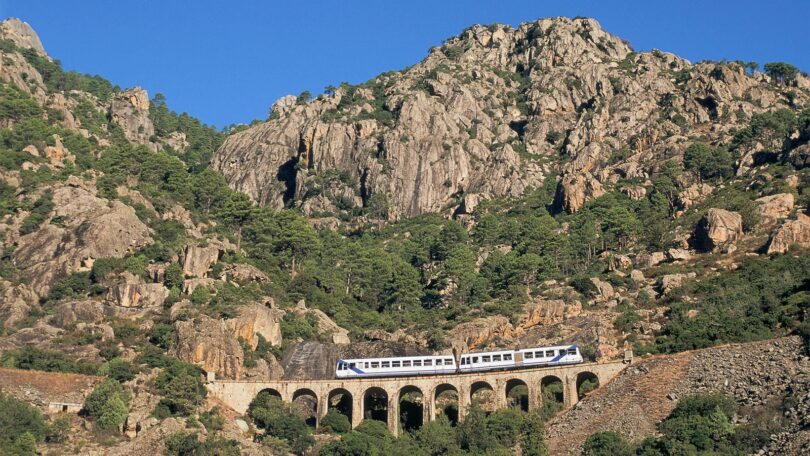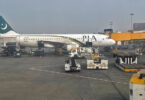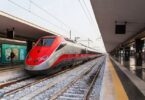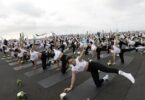Norman Miller
The island of Corsica blends the rugged peaks of the Mediterranean’s most mountainous island with azure beaches, colourful historic towns, lush woods and high plains. No wonder the ancient Greeks named it Kalliste (most beautiful). Even the hard-to-please French – who acquired the island in a still-controversial deal with Italy’s Genoese Republic in the 1760s – call it L’Île de Beauté (The Island of Beauty).
Today, many of the estimated three million annual visitors who descend on this 340,000-person island hire a car to explore Corsica’s twisting valleys and hilltop towns. Many seem unaware that Corsica even has a railway. But its trains provide an unforgettable way to delve into the heart and history of the island. In fact, Le Chemins de Fer de la Corse – or U Trinicellu (Little Train, as locals affectionately call it) – isn’t just one of the best train journeys in Europe; it’s also one of the most affordable, with a one-week pass covering train travel anywhere in Corsica for just €50.
Corsica’s “Little Train” is actually a network linking three contrasting coastal cities on the island’s west (Ajaccio), north-west (Calvi) and north-east coasts (Bastia). The first stage of the railway opened in 1888, and as it expanded in the ensuing decades, it slipped into mountain valleys, climbed up remote hilltops and connected historic interior towns like Corte.
The narrow-gauge railway’s mix of vintage and newer carriages clatter, climb and slalom through a dazzling variety of landscapes at a leisurely pace, and in doing so, represent a distinctly Corsican way of doing things: passengers can take in some of Europe’s wildest landscapes at speeds that rarely exceed 80kmh.
Travelling in the older wood-panelled carriages, meanwhile, offers a cut-price dash of Orient Express vintage glamour. Add the network’s array of “request stops” where, with a quick word to the conductor when boarding, adventurous passengers can be dropped off at remote inland spots for call-of-the-wild hikes, or discover little beach hideaways free of the resort town tourist throngs.
Constructed over two decades at the end of the 19th Century, this 232km iron highway required 20,000 labourers to create 32 tunnels and 52 bridges and viaducts across a jaw-dropping panoply of peaks and gorges. Two years after completing his famous namesake tower in Paris, Gustave Eiffel began constructing the spectacular Pont du Vecchio viaduct near Corte, to carry the Little Train over the plunging landscape.
By the 1960s, however, the Trinicellu faced an existential threat from the rising popularity of the car. Moves were made to close the rail line, driven by a 1959 speech by France’s then-Minister of Transport Robert Buron, who sneered that “cars and five buses” would be enough to meet the transport needs of Corsica.
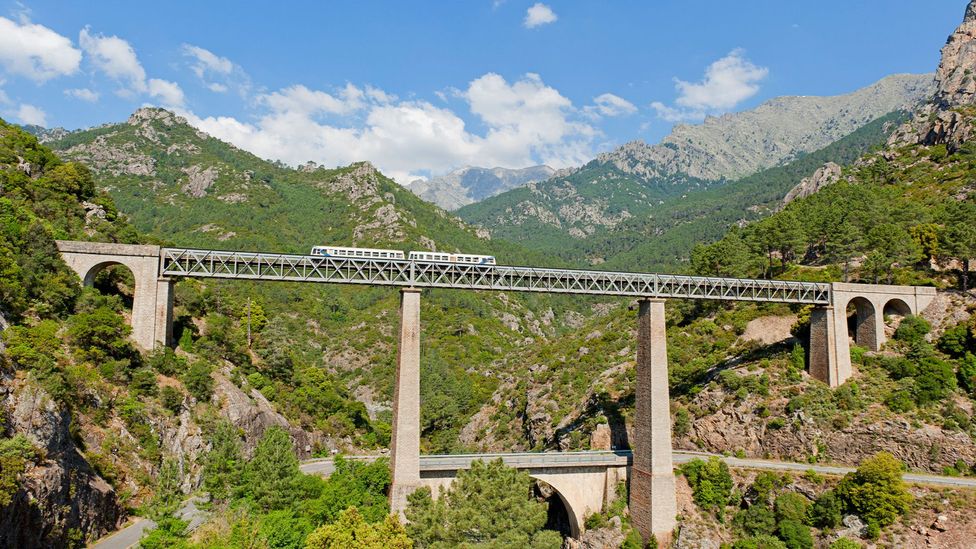
Two years after creating the Eiffel Tower, Gustave Eiffel built the Pont du Vecchio viaduct to carry Corsica’s Little Train (Credit: Allard Schager/Alamy)
This insult from Corsica’s mainland landlords saw protests and widespread strikes sweep across the island, with thousands of demonstrators marching in the streets to defend the island’s train. As French authorities continued to talk of closing the Trinicellu, protests continued for more than a decade until the French government not only backed down, but promised to provide new trains in the 1970s.
Intrigued by the train’s history and how it represents Corsica’s unique blend of brawn and beauty, I flew into Ajaccio to ride the rails for a week before flying out of Bastia. My entire train odyssey cost less than the price of a single tank of petrol, while carrying me from the heart of one town to another in laidback style.
Corsica’s capital, Ajaccio, was the birthplace of French ruler and proud Corsican Napoleon Bonaparte. After visiting the home-turned-museum where Bonaparte was born, as well as the classical paintings of the Musee Fesch, I climbed aboard the Trinicellu bound for the mountain town of Corte.
Tucked away amid an amphitheatre of jagged peaks in the mountainous heart of the island, Corte is Corsica’s physical and historic centre. It was briefly the capital of an independent Corsican nation in the 1790s after homegrown hero Pascal Paoli’s successful uprising against French rule. As my train climbed from the coast into mountains, the tracks seemed to show a similar defiance to gravity. The train clung to the slopes as I stared down hair-raising drops to silvery valley streams far below, while pine and chestnut branches brushed the windows as we cut through wild forest either side of the line.
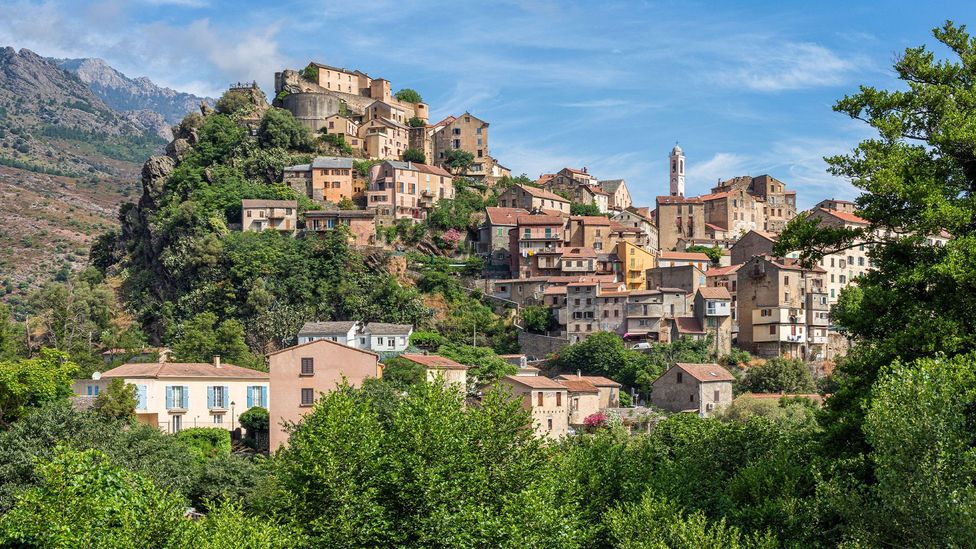
Corte is set in a stunning location in Corsica’s mountainous interior (Credit: Stefano Valeri/Alamy)
“The train is perfect to take you right into the heart of the island, with little effort,” hiker Gabriella Finelli told me just before she and a friend alighted at the village of Vizzavona and disappeared onto a trail that snaked into the forest. The area forms part of the Regional Natural Park of Corsica, a 350,000-hectare expanse of protected forests, lakes and gorges covering 40% of the island.
Corte remains the place where Corsica’s national identity beats the strongest. There’s a sense of local importance in the air, as this 8,000-person town is home to the island’s main university and its finest museum, the Museu di a Corsica (Museum of Corsica). Housed in a 13th-Century fortress atop a soaring crag, the museum evocatively highlights intriguing aspects of everyday Corsican life, such as displays related to the island’s unique, bittersweet Cap Corse Mattei aperitif (made with cinchona bark, mistelle and other native plants), alongside Corsican crafts and old travel posters for the Trinicellu.
Later that day, I hopped back onto one of the Little Train’s older, wood-panelled carriages that wasn’t updated in the 1970s to continue my journey from Corte to Calvi. The vintage carriage clattered for an hour through the wild Navaccia valley, past boulder-strewn rivers and remote hilltop towns, before hitting the coast by the 18th-Century port-turned-resort of L’Île-Rousse for a final 45-minute run into Calvi. The train trundled along an idyllic stretch of coast known as La Balagne, where the tracks ran so close to the sea that I could have almost scooped sand from the dunes we cut right through.
That evening, I took in a glorious concert of Corsica’s stirring polyphonic singing – revived in recent times as a melodic expression of the island’s soul – at the Jean-Baptiste Cathedral in Calvi’s cobbled old town. Using the town as my base, I took short coastal day trips on the Trinicellu, between Calvi and Ile Rousse, which includes a clutch of tiny stops by request (just tell the conductor where you want to get off), including the fortified seaside resort of Algajola, where I swam in the lee of its 16th-Century Genoese fort. When I was finished, I picked up the train again by sticking out my hand at the station, just like one might hail a taxi.

The Little Train chugs from picture-perfect Calvi to a series of coastal destinations (Credit: June Morrissey/Alamy)
My final three-hour trip from Calvi to Bastia saw the Little Train climb to a vast prairie plateau straight out of a Wild West movie. It then eased down to the north-east coast through a landscape dotted with vineyards and woods, criss-crossing sparkling rivers on a succession of old bridges before easing into Bastia.
Bastia exudes a quiet grandeur befitting Corsica’s capital for five centuries. I pottered around its old port area (known as Terra Vecchia), ringed by 18th-Century tenements and dotted with glorious churches. Around the harbour, restaurants vied to serve the best versions of aziminu – Corsica’s version of France’s bouillabaisse fish soup.
On my last morning I headed to the flea market that takes over Bastia’s grand Place St-Nicolas every Sunday, thrilled to discover a stash of old Corsican railway postcards. Though the monochrome images capture the trains from a century before, the Trinicellu’s appeal remains timeless.

